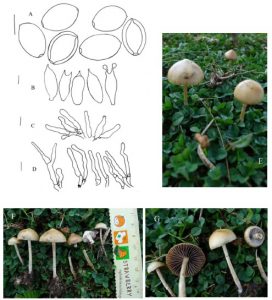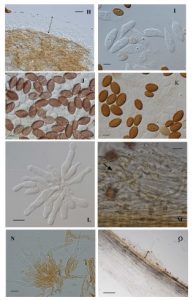Protostropharia luteonitens (Fr.) Redhead, Index Fungorum 148: 1 (2014) Index Fungorum number: IF 550584
Pileus 10–25 mm diameter, conic and brownish yellow (4B4, oac716) when young, then subconic to hemispheric and beige or straw yellow (3A3; oac814), pointedly papillate in centre, often slightly sulcate or striate at margin, shiny when dry, surface smooth, context whitish (1A1, oac909) and relatively hardish. Lamellae adnate, about 4 mm high, close or subdistant, pale gray (1B1, oac907) when young, then becoming yellowish brown (4B5, oac791) with purple tinge, edges serrulate and remaining whitish. Stipe 25–40 mm × 1.0–3.0 mm, cylindrical, nearly concoloured with that of pileus, stuffed to hollow, fragile; surface covered with white floccose scales; base of stipe with white mycelium, sometimes shaped pseudosclerotium; often with annuliform zone in upper half; context yellowish (1A2, oac900) to brownish (4B4, oac797), whitish (1A1, oac909) towards the surface. Odor mild.
Pileipellis an ixocutis, 15–200 μm thick, hyaline, made up of creeping, interwoven, colourless to dark yellowish, 1–5 μm wide filamentous hyphae; subpileipellis yellowish brown in KOH, composed of interwoven, tubular to inflated tubular, 4–16 μm wide hyphae, the wall of hyphe sometimes incrusted with some blackish material. Stipitipellis also an ixocutis, 15–100 μm thick, composed of interwoven, hyaline, colourless to dark yellowish, 2–5 μm filamentous wide hyphae, the wall of hyphe smooth or rough. Subhymenium subcellular, composed of irregular vesicular cells. Hymenophoral trama subregular to interwoven, with cylindrical hyphae 2–13 μm diam, hyaline, colourless to dark yellowish, wall smooth or sometimes slightly rough. Basidia 28–37.5 × (9–)10.5–15.5 μm, hyaline and colourless, subcylindric to clavate, 2-spored and 1-spored, rarely 3-spored, sterigmata (2–)3–7(–8) μm. Basidiospores (108/3/1) (13.5–)14.5–20(–25) × (8–)9–12.5(–16) × (7.5–)8.5–12.5 μm, ellipsoid or subellipsoid in face view, Q = (1.4–)1.5–1.7(–1.8), Q = 1.59±0.08; ellipsoid or subellipsoid in side view, Q = (1.3–)1.5–1.8(–1.9), Q = 1.65±0.10, purplish brown in water, yellowish brown in KOH, dark purplish brown in deposit; wall smooth, thick (1–1.5 μm) and complex, with distinct 1.5–3 μm wide, often slightly eccentric in side view apical germ pore. Cheilocystidia 20–35 × (4–)5–9(–11) μm, hyaline and colourless, occasionally yellow-brownish, cylindric, cylindric-clavate, clavate to sublageniform, often with a rounded apex. Caulocystidia abundant, 18–63 × 3.5–8(–10.5) μm, hyaline, colourless to yellow-brownish, cylindric, sometimes clavate or sublageniform, often more or less flexuous. Clamp connections abundant.
Known distribution: Known from North America, Europe and Asia (Japan) (Guzmán 1983, Stamets 1996, Noordeloos 2011), found for the first time in Yunnan Province, southwest China.
Habitat: Growing scattered to gregarious on soil of a meadow close to a river where cattles and horses have grazed in summer.
Material examined: CHINA, Yunnan Province: Zhaotong, Zhaoyang district, Tiaodun river of Dashanbao, 27°24′37.6″N, 103°17′34.5″E, elevation 3132 m, 30 Aug 2011, Tao Ma and Xiao-Fei Ling, ZY029 (IFRD415163).
FIGURE. Protostropharia luteonitens A Basidiospores. B Basidia. C Cheilocystidia. D Caulocystidia. E–G Basidiocarps in the field. Scale bars: A–D = 10 μm.

FIGURE. Protostropharia luteonitens H Pileipellis 400×. I Basidia 1000×. J Basidiospores mounted in water, 1000×. K Basidiospores in KOH, 1000×. L Cheilocystidia 1000×. M Stipitipellis 1000×. N Caulocystidia 1000×. O Stipitipellis 100×. Scale bars: I–N = 10 μm. H = 20 μm. O = 100 μm.

